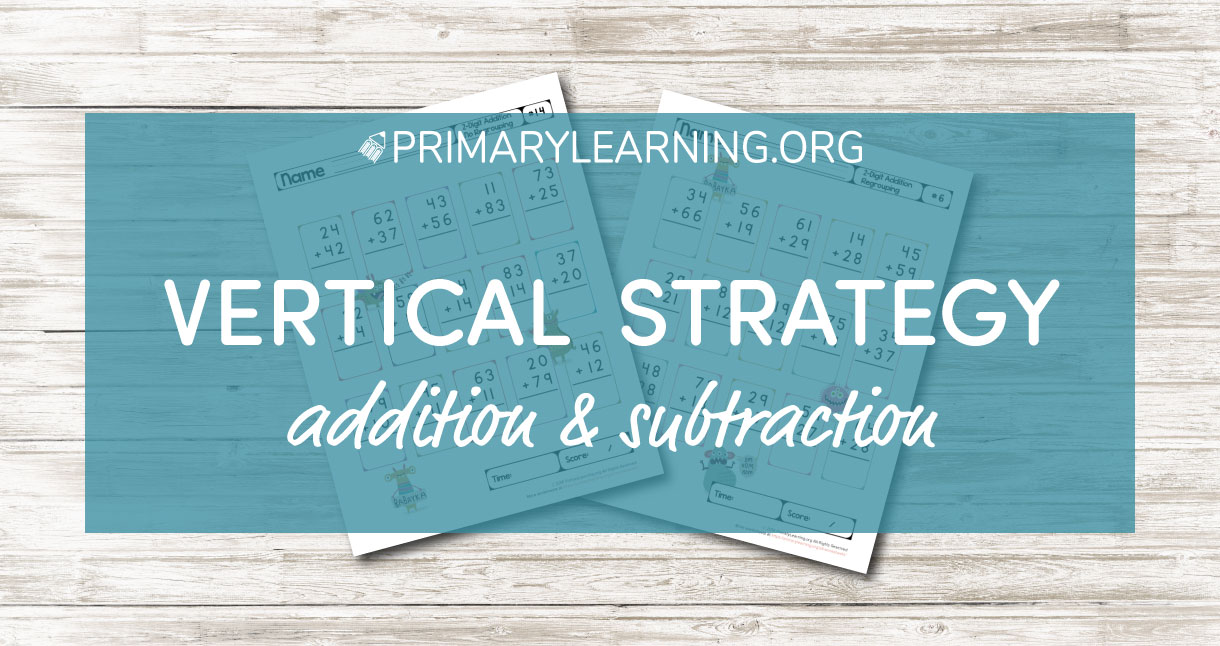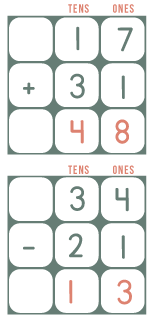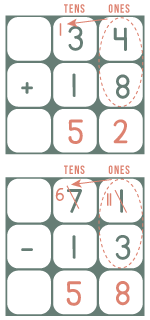

Posted by: Alesia Netuk
Updated: October 2nd, 2023
Vertical Addition and Subtraction Strategy
Vertical Addition and Subtraction Strategy
This article will explain the addition and subtraction of two- and three-digit numbers using a vertical strategy. The vertical strategy is when students place one number above the other according to the value it has. First hundreds, then ten and ones. In this method, students use vertical columns to add or subtract numbers. It may require regrouping (trading) – replacing the quantity of smaller or bigger parts without modifying its value.
In second grade, when kids develop fluency besides and subtraction of two-digit and three-digit numbers. There are many strategies students can use: jumping strategy, hundreds chart, split strategy, compensation strategy, block strategy, ten frames strategy, and mental strategy.
Since the end of the XXth century, some US programs, including TERC, decided to remove the traditional transfer method from their curriculum. This decision was criticized that is why some states and counties didn’t support this experiment.
Vertical Addition and Subtraction without Regrouping
Vertical addition without regrouping.
The sum is less than 10, so no regrouping (trading) to the tens is required.
Vertical subtraction without regrouping.
Fewer tens are being taken away, so no regrouping (trading) is required.


Vertical Addition and Subtraction without Regrouping
Vertical addition with regrouping.
The addition will involve regrouping (trading) when two digits in the column make more than ten. 4 ones + 8 ones = 12 ones. We do not place more than 9 in a column. 2 = 1 ten and 2 ones, then 1 ten goes to the tens column and 2 ones stay in its column. 1 ten + 3 tens + 1 ten = 5 tens. All tens in its column now are added together.
Vertical subtraction with regrouping.
Subtraction with regrouping will appear when there are more ones, tens, or hundreds in the number being taken away. Students will trade digits from larger columns (tens will trade with hundreds, ones will trade with tens). 1 one – 3 ones = … We can not take away 3 from 1, so we need to regroup the tens column. 11 ones – 3 ones = 8 ones, while 6 tens – 1 tens = 5 tens.
Addition and subtraction worksheets:
Two Digit Addition (No Regrouping) #1
This worksheet helps kids learn about the triangular prism in several engaging but simple steps. Children can label the shape, draw their triangular prism, and count the edges, faces, and vertices.
Two Digit Addition (No Regrouping) #2
Bring fun into your classroom and let students solve two-digit addition no regrouping problems with cute little monsters.
Two Digit Addition (No Regrouping) #3
Two-digit addition no regrouping colorful worksheet is a great way to boost these skills and turn math practice into a fun learning time.
Two Digit Addition (No Regrouping) #4
In this worksheet, kids will practice two-digit addition without regrouping. Kids will solve fifteen math problems with cute monsters.
Two Digit Addition (No Regrouping) #5
Practice addition with adorable monsters. 2 digit addition without regrouping printables available in color or B&W copies.
Two Digit Addition (No Regrouping) #10
Fun math practice with cute monsters! With this worksheet, kids will practice two-digit addition problems without regrouping.
Two Digit Addition (No Regrouping) #9
Looking for a fun way to boost your child’s addition skills? 2 digit addition without regrouping worksheets are great for mastering math.
Two Digit Addition (No Regrouping) #6
Two-digit addition without regrouping worksheet to practice fundamental math skills. Have your child solve 15 addition problems with monsters.
Two Digit Addition (No Regrouping) #7
Two digit addition without regrouping worksheets are great for practicing fundamental math skills. Practice addition with cute monsters.
Two Digit Addition (No Regrouping) #8
Two digit addition without regrouping worksheets with cute monsters are great for practicing fundamental math skills.
Two Digit Addition (No Regrouping) #11
Our two-digit addition worksheets without regrouping will help kids to master the fundamental math skills and solve addition problems quickly.
Two Digit Addition (No Regrouping) #12
Our collection of two-digit addition without regrouping worksheets is excellent for practicing fundamental math skills.
Two Digit Addition (No Regrouping) #17
Are you looking to boost your second-grade math skills? Check out these incredible double addition worksheets. Math is not bored anymore!
Two Digit Addition (No Regrouping) #13
Addition worksheets without regrouping with cute monsters are great for mastering your child’s fundamental math skills.
Two Digit Addition (No Regrouping) #19
Challenge your second grader to complete the page with double-digit addition no regrouping worksheet full of cute monsters.
Two Digit Addition (No Regrouping) #14
Are you looking for more math practice for your second grader? Practice the addition of 2 digit numbers without regrouping with this great worksheet.
Two Digit Addition (No Regrouping) #20
Two-digit addition without regrouping pdf worksheet with these cute monsters. There are fifteen math problems for your child.
Two Digit Addition (No Regrouping) #15
Your child will enjoy practicing addition without regrouping with these cute monsters. Math practice now is a fun learning time!
Two Digit Addition (No Regrouping) #16
Practice, practice, practice! Kids will love to practice double-digit addition problems with this colorful worksheet and little monsters.
Two Digit Addition (No Regrouping) #18
Practice excellent math skills with colorful double-digit addition without regrouping worksheets. Great for second graders.
Two Digit Addition (Regrouping) #1
With our two-digit addition worksheets, students will get a lot of practice and boost their math skills without regrouping.
Two Digit Addition (Regrouping) #1
Two Digit Addition (Regrouping) #10
Help your child sharpen her math skills with this double-digit addition regrouping worksheet with cute monsters.
Two Digit Addition (Regrouping) #10
Two Digit Addition (Regrouping) #3
Fifteen addition problems to work on for your child will not be boring; check the adorable addition worksheets with regrouping collection.
Two Digit Addition (Regrouping) #3
Two Digit Addition (Regrouping) #4
Double-digit addition scared your child? Check two-digit addition worksheets with regrouping series and practice with cute monsters.
Two Digit Addition (Regrouping) #4
Two Digit Addition (Regrouping) #2
You are looking for practicing two-digit addition that will not be boring for your child? Check these ads with the regrouping worksheets series.
Two Digit Addition (Regrouping) #2
Two Digit Addition (Regrouping) #6
Practice perfect math addition with regrouping and improve your child’s fluency skills. She will solve a bunch of problems with cute monsters.
Two Digit Addition (Regrouping) #6
Two Digit Addition (Regrouping) #5
This printable addition to regrouping worksheets will help your child master her math skills and solve problems using vertical strategy.
Two Digit Addition (Regrouping) #5
Two Digit Addition (Regrouping) #7
Understanding math addition regrouping is an essential skill that will help students build more advanced math concepts.
Two Digit Addition (Regrouping) #7
Two Digit Addition (Regrouping) #8
Is your child bored of solving lots of problems? Not anymore! Practicing two-digit addition regrouping with cute monsters is fun for everyone.
Two Digit Addition (Regrouping) #8
Two Digit Addition (Regrouping) #9
Looking to make addition practice fun and engaging for students? This adorable addition 2 digit with regrouping worksheet is all you need.
Two Digit Addition (Regrouping) #9
Two Digit Addition (Regrouping) #12
Are you looking to make addition even more interesting for kids? Our collection of 2 digit addition worksheets with regrouping is suitable for you.
Two Digit Addition (Regrouping) #12
Two Digit Addition (Regrouping) #15
Grade two addition regrouping worksheets help kids build math fluency. Get your second-grader to solve problems and look around for monsters.
Two Digit Addition (Regrouping) #15
Two Digit Addition (Regrouping) #11
Looking for 2 digit addition with regrouping worksheets that not only educate but also engage your child? You are in the right place.
Two Digit Addition (Regrouping) #11
Two Digit Addition (Regrouping) #13
Looking for more engaging addition practice? Check these 2 digit regrouping addition worksheets with cute monsters.
Two Digit Addition (Regrouping) #13
Two Digit Addition (Regrouping) #14
Your students will find regrouping with addition problems with this cute worksheet, and math will not be boring anymore!
Two Digit Addition (Regrouping) #14
Two Digit Addition (Regrouping) #16
2 digit addition with regrouping worksheet helps children develop math fluency. Solve bunch of addition problems and look around for monsters.
Two Digit Addition (Regrouping) #16
Two Digit Addition (Regrouping) #17
Is your child struggling with math? This worksheet addition with regrouping will help to build her confidence with two-digit addition.
Two Digit Addition (Regrouping) #17
Two Digit Addition (Regrouping) #18
Is your kid struggling with math? Our regrouping with addition worksheets helps your child solve two-digit addition using a vertical strategy.
Two Digit Addition (Regrouping) #18
Two Digit Addition (Regrouping) #19
Addition can be confusing for your second grader. Our collection of regrouping worksheets addition will help her to build math fluency.
Two Digit Addition (Regrouping) #19
Two Digit Addition (Regrouping) #20
Practicing math skills with our two digit addition regrouping worksheet will not be bored for your second-grader.
Two Digit Addition (Regrouping) #20
LEARNING MATERIALS TO MEET EVERY CHILD’S NEEDS
Here, at PrimaryLearning.Org, we tend to deliver the best-differentiated learning materials to K-2 students. Our resources can be easily incorporated into multisensory lessons to meet every child’s needs, whether s/he is a visual, kinesthetic, or auditory learner.